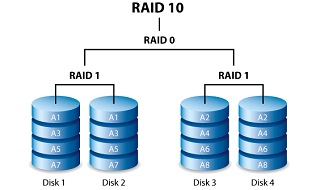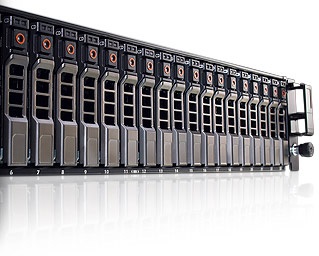RAID 10 Data Recovery by the Authority in Data Recovery
RAID 10 Data Recovery Services
 RAID 10 is a popular enterprise RAID system for many reasons, but mainly because its robust structure actually consists of a Stripe of RAID 1 mirrors, with a RAID 0 setup created over top.
RAID 10 is a popular enterprise RAID system for many reasons, but mainly because its robust structure actually consists of a Stripe of RAID 1 mirrors, with a RAID 0 setup created over top.
The combination of a mirrored configuration with striping added is referred to as RAID 1+0 (also called RAID 10). In this scenario, the configuration will provide mirroring (RAID 1) across two (2) or more drives and will "stripe" the data in real-time to a second mirrored drive set. This unique combination will provide data redundancy and some speed advantages, but it does so at the expense of usable storage space. Another implementation is RAID 0+1 . In this scenario, the configuration will provide striped (RAID 0) across two (2) or more drives and will "mirror" the data in real-time to a second stripe drive set.
This enables not only superior replication and shared data, but also simpler seek and read operations, as well as simple rebuilding in case of single hard drive failure. This configuration combines the high speed of RAID 0 with the data redundancy features of RAID 1, all without the need for parity calculations.
The data is mirrored identically across the member disks. This can lead to a false sense of security, even the most secure systems can be wiped out by power spikes, multiple drive failure etc.
RAID 10 systems are typically used for processor-heavy applications such as Online Transaction Processing or Microsoft Exchange. The overall positive inherent in the RAID 10 setup makes them the perfect choice because of the rebuild ease. But in cases where the RAID 10 array has failed, regular IT pros can, sometimes, be stymied by the complexity, and should not attempt
RAID 10 data recovery. Particularly in cases of RAID controller failure or server registry loss, most IT professionals do not have the experience or the tools to perform a successful RAID repair.
 RAID manufacturers differ vastly in their designs of the internal components and circuitry of their hardware and an in-depth knowledge of these designs are crucial for successful data recovery. But because manufacturers do not disclose this information, RAID recovery techniques require many years of development and reverse engineering in order to determine which ones are the most effective.
RAID manufacturers differ vastly in their designs of the internal components and circuitry of their hardware and an in-depth knowledge of these designs are crucial for successful data recovery. But because manufacturers do not disclose this information, RAID recovery techniques require many years of development and reverse engineering in order to determine which ones are the most effective.
Being experts in the recovery of both single hard drives and striped volumes
perfectly places ACE Data Recovery to recover your critical files from
this and any other type of array/volume.
Our RAID data recovery process meets manufacturer’s requirements.
We recover data from any hard drive RAID arrays made by but not limited to the following manufacturers:
